Research Article
ORNITHOLOGICAL TOURISM- SUSTAINABLE TOURISM DEVELOPMENT OPPORTUNITIES FOR POVERTY REDUCTION IN PONG DAM WETLAND OF HIMACHAL PRADESH
17666
Views & Citations16666
Likes & Shares
Himachal Pradesh a mountainous state of North India has been God gifted by 92 wetlands covering nearly about 98496 hectares area of land. Wetland attracts migratory birds to the beautiful landscape coming from different parts of the world as a migration stopover, wintering area or breeding area. Bonded by beauty, Himachal Pradesh attracts quality tourists to the state. Natural capital of the state in the form of varied variety of flora and fauna gives a new dimension to the tourism activity. Ornithological Tourism is the next big step in the field of tourism promotion both for the bird watchers and the local population along with stakeholders. Communities look for benefits from the local resources emerging in the area. The present study tries to create a sustainable and responsible tourism product in the field of ornithology in the wetlands of Himachal Pradesh.
Keywords: Wetlands, Quality tourists, Ornithological tourism
The demand pattern of tourism resources and products is changing in the dynamic world. The change pattern in the consumption of tourism products is due to association of various activities directly or indirectly with tourism sector. Tourism provides more than 10% of employment in the world adding a contribution of 16% to the global GDP Sfougaris (2009). The development in the field of tourism showcases variety of tourism forms not being restricted to one section of society or to a particular type of tourism products. Advancement in the education level, better travel connections, more disposable income and last but not the least 24X7 availability of information on tourism products allow tourists to select locations with different unique selling proposition (USP) in return brings an incremental change in the tourism activities. In this process of change stakeholders in tourism activities of Himachal Pradesh is also not far away to attract quality tourists. The stakeholders in tourism of Himachal Pradesh are also looking to start new and varied forms of tourism activities, which move the state from mass tourism to niche tourism destination. In the efforts Ornithological tourism can be one of the next big steps in the direction. According to the World Tourism Organization, ornithological tourism, bird watching or birding tourism, or avi tourism, can be understood as the activity that involves moving from a place of origin to a specific destination, whose main purpose is to observe local avifauna in its natural environment (http://www.turismodearagon.com/en/plan/ornithological-tourism.html).
Birds have attracted human beings from the birth of the child looking at different type of birds in the vicinity and naming them with the baby tongue. The shifting of just admiring the birds in the form of hobby or for leisure activity, into passion to recognize the various variety of birds with their morphology, colors and singing and attached to the passion, make people move outside their local environment for more than 24 h, allows researcher to throw light on the scope of ornithological tourism. Himachal has been bestowed with natural beauty in terms of wide variety flora and fauna. This beauty attracts a variety of water birds to the wetlands of the state. Himachal Pradesh has 92 wetlands covering 98496 hectares area, out of which 85 are natural and 7 are man-made which constituted one percent of the total geographical area (himsamachar.com/about-1-23-lakh-migratory-birds-visit-pong-dam-lake). Pong Dam Lake, Chandratal and Renuka have been identified as Ramsar sites whereas Rewalsar and Khajiar lakes under national wetlands. Wetlands provide shelter to one of the richest biodiversity of the world along with sustainable tourism growth opportunities to the local population living in the area.
WETLANDS
7% of the world’s total area is in the form of wetlands. According to Oxford dictionary wetlands are Land consisting of marshes or swamps, saturated land. In the general context wetlands are the places either created by the natural activity of the Mother Nature or created artificially by the human beings for one or the other activity associated with water. Wetland acts as a separate ecological diversity. They provide a different survival condition to the dependent variable, including human beings and birds. The number of birds staying in a particular wetland is a good indication of the ecological balance of the region (Report National wetland conservation Programme, 2009). Wetlands have been divided into various categories by the Ramsar Convention on Wetlands. Wetlands are divided as three main habitat centres (1) Marine / Costal wetlands such as beaches, estuaries, lagoons, mangroves and coral reefs; (2) Inland wetlands such as lakes, rivers, peat land, marshes, streams, creeks and waterfalls; (3) Man- Made wetlands such as rice fields, canals and ponds (www.ramsar.org).
(Laiola, 2004) in the paper have looked to understand the bird community overwintering in the Himalayan subalpine zone and its compatibility with tourism with the dimension of habitat structure and bird–habitat relationships. (Wolf, Hagenloh & Croft, 2013) emphasized on the over usage of hikes or trekking routes along the bird community areas decreases the variety of bird species and their abundance leading to loosing of the best species of birds in the area. The greater impact of more intervention on the biological diversity from tourism with a greater number of tourists entering into the sites can lead to more over usage of the protected area with can lead to conditions not fit for proper functioning of the biological ecosystem (Salgueiro et.al, 2019). In some of the cases the presence of human in the local habitat of birds makes them more use to the intervention created by the local community and the tourists visiting the destination. (Bhalla, Bhattacharya & Gupta, 2015). citing the work of Rome (1999) has emphasized that non-availability of base line data with the initial start of projects at the biodiversity conservation area makes it more difficult to assess the problems and prospects associated with the same. In number of studies monitoring of the wetlands and the data mapping and geo tagging of available avifuana has been suggested for the long-term tunnel vision approach to protect the biodiversity along with tourism as an activity (Peetabas &Nanda, 2015). (Ffench, 1985). (Alwis, Perera & Dayawansa, 2016). In the Pong Dam Wetland, the same type of challenges has been identified as highlighted by (Harwood& Noske, 2014) in their work with emphasis on the problems of land use planning and property system to administer the usage of land holding patterns among the local community along with the land rights governed by Bhakra Beas Management Board (BBMB) and Forest Department, Himachal Pradesh.
WETLANDS OF INDIA
Wetlands occupy nearly 58.2 million hectares of the land (Prasad, 2009) including area under paddy cultivation (Directory of Indian Wetlands) with 19 different types of wetlands present giving life to the flora and fauna in the region. Wetlands in India range from High altitude lakes like Tso Morari in Leh region of Jammu and Kashmir to the Sunder bans in West Bengal. These wetlands attract birds from the Trans Himalayan region, Siberia and other parts of the world to stay here either for a short span of time for different reasons making most suitable conditions for them. Wetlands act as migration stopover, summer place or breeding sites for variety of local and migratory birds.
Wetlands and Himachal Pradesh
Himachal Pradesh covers an area of 55673 Km2 of Indian subcontinent. Himachal Pradesh is bestowed with pristine beauty in the form of wide variety of flora and fauna with beautiful coniferous trees, snow clad mountains and gulping snake like water bodies adding to its beauty. Wetland has an important place in the hill state. Wetland covers the maximum of 10.63% geographic area in the Bilaspur District of the state with the least of 0.46% in the Shimla district (Table 1). In reference to the wetland % area Kangra leading all the way with 34605 hectares of area under the wetlands. (Directory of Indian Wetlands) (Figure 1).
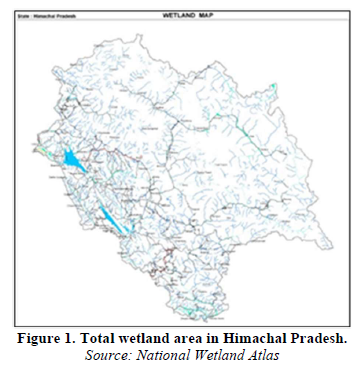
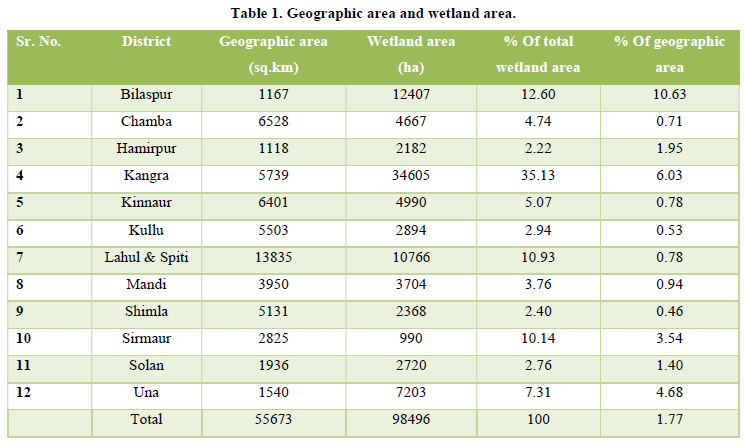


KANGRA AND WETLANDS
Kangra is an important place for the tourists in the Jwala Mukhi, Chamunda Devi, Chintapurni, Bagla Mukhi temple etc. The Pong Dam or Maharana Pratap Sagar Dam at the close borders of Punjab and Himachal is an important wetland. A manmade lake created in the year 1975 on the Beas River in the foothills of Himalayas has become a paradise for the birdwatchers admiring the variety of birds. Tough contrary to the tourist statistics on the total tourist inflow in the region of Kangra no data is available of the bird watchers in the Pong Dam area. Migratory birds come mainly from the Trans Himalayan region of Russia, Siberia, Tibet and Central Asia. Contrary to the same a good number of studies give a clear indication of the variety of birds and the number of different birds coming to the region. From the touristic point of view no data is made available on the grounds on the tourists specially coming to Pong Dam for bird watching activity. Only statistics of the total no. of birds and variety of birds is made available by the efforts of various organizations (Figure 2).
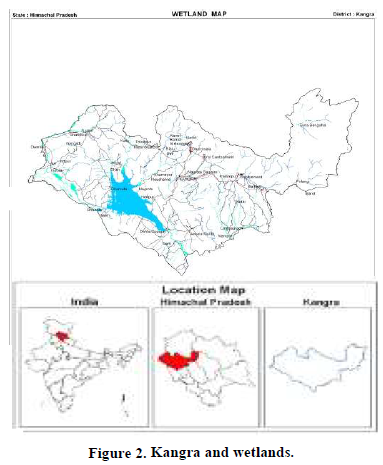

KANGRA AND TOURISM
The tourism traffic to the hill region of Kangra is more restricted to few regions in the area or more specifically to the areas of Mcleodganj in Dharamshala, Dalhousie town, Khajiar in Chamba. These destinations are popular for the natural lovers of beauty and on the other the research and trend spotting shows the other type of tourist in the area to classify in the category of mass tourism comes in the form of religious tourist. The main spots of religion in Kangra district of Himachal Pradesh are Jwalaji, Chintapurni, Chamunda Devi, Bagla Mukhi etc. Few of the tourists in the current times are showing interest in the trekking regions like Triund, Inderhara Pass, Kareri Lake Trekking, Gunna Mata Trekking etc. (Table 2).
The above statistics is not showing a positive sign towards the growth of tourism in Kangra district as in the year the no. of domestic and international tourists has decreased. This reasons behind the same to be mentioned here Firstly, better air connections in the bordering state of Jammu & Kashmir, Secondly Himachal Pradesh only promoting a same kind of tourism from number of years with sectors of Shimla-Kullu / Manali or Dalhousie - Dharamshala. This brings a great pressure on the destination with the concept of carrying capacity. Thirdly, opening of tourism in the state of Jammu and Kashmir with more control on terrorism activities. New and variety of tourist attractions in Himachal Pradesh can be the only remedy to this problem of decrease in the tourist traffic to the state. A new segment of tourist is coming in the recent times is the individual youngsters. They are less interested in a pilgrimage and more interested in the different and adventure activities with better staying options. The few reasons to mention here is good and handsome salary packages paid to them by private companies but lesser time available as busy with jobs. This type of niche tourist is finding new destinations with 6-to-7-night packages or a getaway city break package (Figure 3).
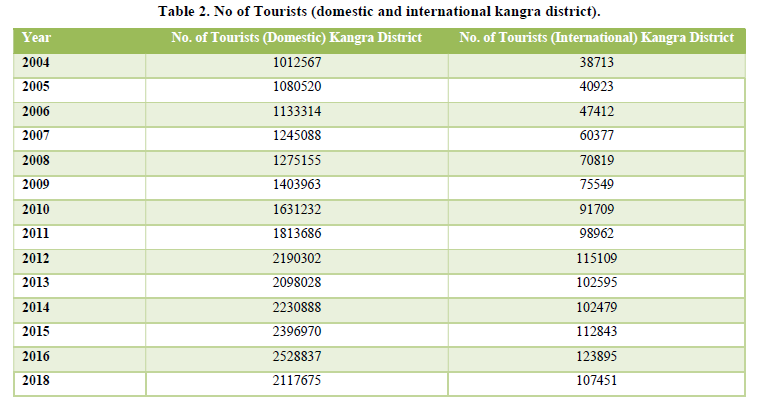
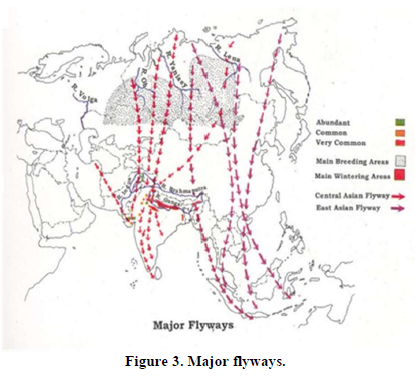


BIRDS OF HIMACHAL PRADESH
Himachal is a home of variety of birds. More than 400 species have made Himachal as their home. Some of them love to stay in Himachal as permanent nature and good number of birds in the form of migratory birds coming from far flung areas. The work of researchers has revealed that the maximum birds were seen in the Pong Dam (73.60% of the total birds); secondly it is Balh Valley (59.32%), Nalagarh area (51.86 %) and the least biodiversity of birds has been found in Kaza valley ranging (19.25%) Thakur, (2013). The diversity ranges from migratory birds, low mountain range birds to the high-altitude birds. To name few the main birds found in the Himalayan region of Himachal Pradesh are Western Tragopan (State Bird of Himachal Pradesh), Cheer Pheasant, Brooks Leaf Warber, Kashmir Flycatcher, Orange Bluefinch etc. are on the verge of extinction. The northern paintail, common pochard, the tufted porchard are regular visitor to the wetlands of Pong Dam. Himachal Pradesh has identified seven world endangered species.
WORLD ACTIVITIES IN BIRD PROTECTION
Actions of various organizations, associations, individuals and groups are well appreciable in the field of Bird Protection. Most of the activities are mainly dedicated among the few individuals of similar interest turning their hobby into passion of bird watching. Government bodies have also pulled up their socks in finding the ways in protecting both flora and fauna of the region. The action plan of the various individuals along with the real stakeholders needs to be brought in the same platform to understand the real growth of Ornithological tourism in the state in return giving lively hood to the local community and better place for these birds to get attracted to the state of Himachal Pradesh. The organizations at the international level have well understood the importance of birds living in their area and the birds coming as migratory birds in the area. (Figure 4).
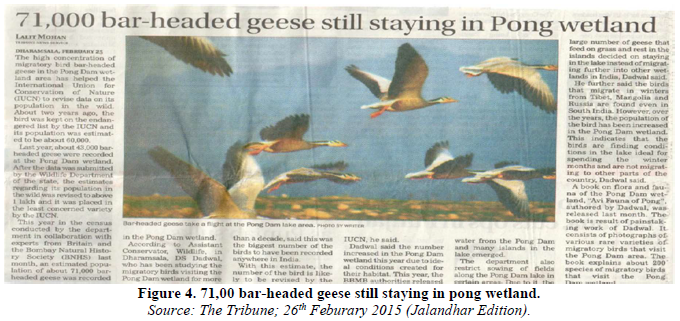

The world migratory Bird Day: The world migratory bird day was celebrated on 11-13th May, 2013 as an action-based programme to protect the migratory birds. This has now become an annual event to promote tourism along with migratory bird in the region. The efforts are more concentrated to the few regions of the world. In this programme this action-based activity people around the world are motivated to organize various activities parallel with the theme. Few activities to outline are public events on the birds, education programmes and excursion on birdwatching. The importance in protection in the migratory birds becomes more important as their main dependence is not only on their natural habitat but also on the place where they stop either for breeding or a point of stoppage to move to the next destination (www.worldmigratorybirdday.org) (Figure 5).
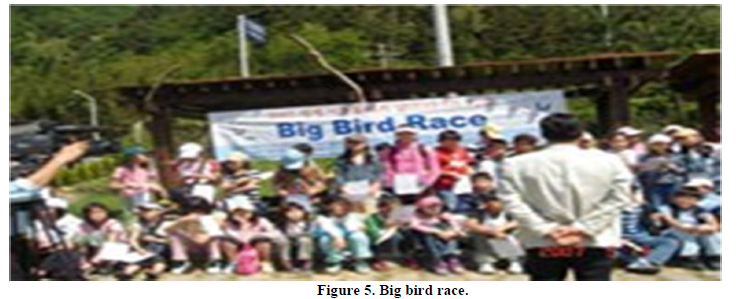

Bonnechere Parks: Bonnechere Parks Ontario, Canada is looking to bring a new dimension to the flora and fauna of the region. The organization is organizing the school trips, excursions to help protect the birds and increase the interest of local community in the nature. The team has developed educational resources for the school children in the form of games and other material to promote the bird watching in the area (Figure 6).
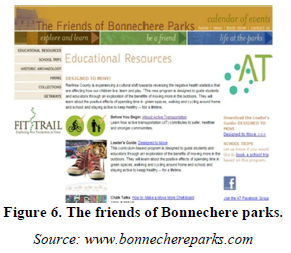

Bird Festival: Different countries all over the world are organizing the bird festival. One of the prominent countries in the same is Israel with their Hula Valley Bird Festival and Eilat Bird Festival. In the promotion of tourism, the partners in these festivals are Ministry of Tourism, Israel, Society for protection of Nature in Israel, The international center for the study of bird migration, The Hoopoe Foundation. The same efforts all the organizations in India are required to promote Ornithological Tourism in the hill state and particularly in the Pong Dam region (Figure 7).
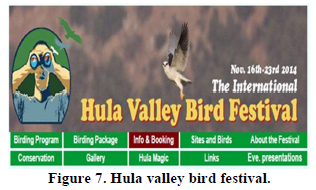

Wetland Protection: The Ramsar convention, wetlands organization and many private and public organizations are putting their genuine effort in helping the protection of the wetlands. The efforts of these types of organizations have helped in increase of variety of birds in Himachal Pradesh. The research has shown there has been a steep increase in the number of birds in Himachal Pradesh with 1.23 lakh migratory birds arrived at Pong Dam wetland with an increase in species of birds from 95 in last year to 113 this year. Bar Headed Goose, Northern Pintail, Common Pochard are few to name here (Figure 8). Continuation to the research activities in the area Whooper Swan has selected Pong Dam wetland after a long-awaited period of 113 years. Past records show last time it was spotted in the area of Talwara nearly in 1900’s. The increase in number of birds in the region has been due to the full efforts by all the organizations like Bombay Natural History Society, Zoological survey of India and Wildlife Institute of India. The higher ranges also been an eye witness to few rare of the rarest species of the world. In one of the research activities brought a remark on the threatened vulture species- Himalayan Griffon (Gyps Himalayensis) showing its aura at Kalatop Khajjar Wildlife Sanctuary in the Chamba district of the state (Thakur and Mattu, 2011). A remark by the Indian Bird Conservation Network (IBCN) has been able to spot and count the vultures and later tried to showcase a rich and healthy biodiversity of the region (Figures 9 & 10).
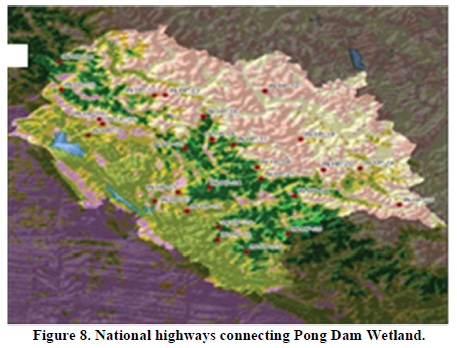
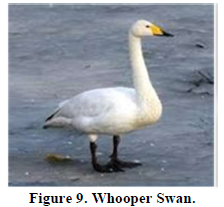
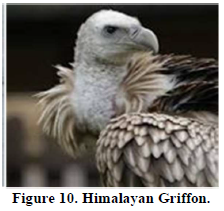



Birds, Wetlands and Tourism: Himachal has been bestowed by God with variety of flora and fauna. A variety of avifauna brings a new dimension to the tourism activities in the state with quality of wetlands attracting the birds in the region. Tourism has been from times immemorial when, travelers like Hsuan Tsang and Ibn Battuta travelled lakhs of kilometers to understand the culture, ethnicity and social life of Indians. Tourism in the region of Himachal Pradesh has been looked with only few sectors and few sections getting benefited by it. Understanding the demand pattern of the new quality tourists in the state a variety of products can be showcased increasing the interest of the tourist in the new forms of tourism. Tourism activities does not only look forward to start with five-star hotels, better modes of transport and good quality food, on the contrary tourism needs to be taken to the areas not explored yet ready to reveal its beauty to the world. Birds can be a great contributor to the tourism activity along with wetlands of Himachal Pradesh. This combination gives a great scope for tourism activity to attract quality tourists in the region of Himachal Pradesh. The research shows a full-hearted effort by the stakeholders in wetlands, bird’s conservation and tourism, which could help in the better development of the regions. The positive work in the area of wetland conservation automatically leads to reduction in poverty in the region with better tourism institutional growth opportunities development (www.ramsar.org/tourism Destination Wetlands Supporting sustainable tourism. The main aim in the regions has to be in the better development of sustainable economic strategies for the pro- poor people of the region. Business realities of tourism need to be developed in the way which brings a socio-economic benefit to the society creating a wide variety of sustainable and responsible tourism products.
SUSTAINABLE ORNITHOLOGICAL TOURISM MODEL IN THE WETLAND OF PONG DAM
The goals of conservation with poverty elevation and increase in the tourists can be done with the help of better developed, local community approach of tourism in the field of ornithology. The locals of the region can bring the change and can be a reason for change in ornithological tourism. This tourism activities in the last will help in creation of Tourism development, Poverty reduction, Institutional development and last but not the least wetland conservation giving a land and shelter to birds of the region and abroad (Figure 11).
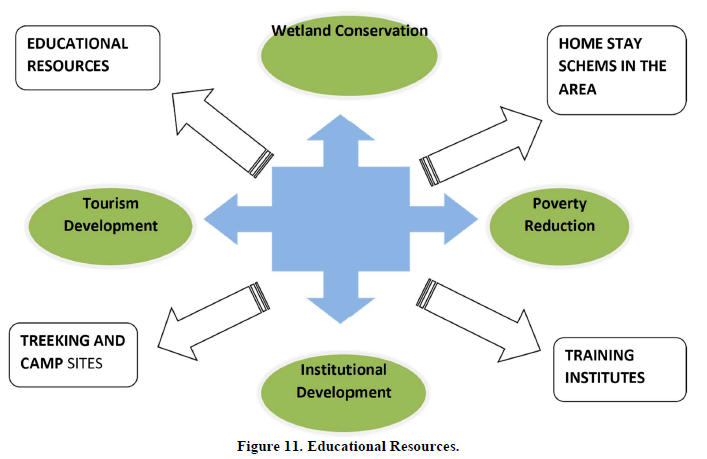

Educational Resources: The state wildlife protection department along with the government of Himachal Pradesh needs to create educational resources and send these resources free of cost to the educational institutes of Himachal Pradesh. This will help the small school children in identifying wide variety of birds and other flora and fauna. These resources can be added in the form of online educational games, Puzzles and small art and craft activity.
School Treks and Excursions: Further to the same various schools are organizing the school treks and excursions every year. These types of activities should be more clubbed with Ornithological tourism. An onsite of trekking, rock climbing, rappelling etc. can be added to the same where these sites of Ornithological importance in return gives an opportunity to grow and develop as true tourism spots. A tourism infrastructure can be developed using the local resources of men and material giving a feel of village to the young future of India. (Figure 12).
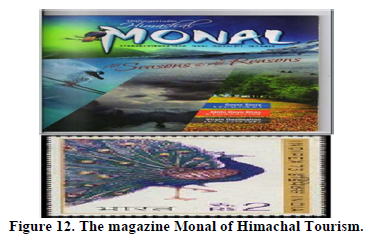

Home stay scheme: Looking at the pattern of demand of by the tourist with simple, clean and better to live-in accommodation to Government of Himachal Pradesh in the year 2008 Himachal Pradesh started a well acclaimed Home Stay Scheme. The benefits of the same are only going to the few in the bigger cities with more touristic importance. The government home stay scheme should be taken ahead and made a part of tourism products in the form of ornithological tourism itineraries. The tourism development corporation should give due importance to the birds of Himachal Pradesh in various publicity material. The magazine Monal of Himachal Tourism is trying to do the best to attract quality tourist. On the contrary Ornithological tourism should be made a unique selling proposition for the state of Himachal Pradesh.
Philately: The interest of the children should be increased in philately. “Philately is the hobby of collecting stamps”. The hobby of children in collecting stamps and launching of stamps by Government with rare and endangered species pictures will allow the children increasing their interest in both the hobby of Philately and also in the birds of rarest of rare species (Figure 13).
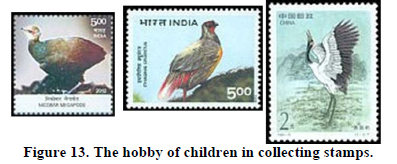

Training institution with community building approach: The current dimensions of the local community can be seen with the drift and shift of local population towards the bigger and major cities of the state and country. To name few reasons behind the same is the paucity of job opportunities in the vicinity. A better utilization of local population in providing them training in the training institutes will allow and focus on the job opportunities in the places of their origin. Training institutes with help of public private partnership will allow developing the talent which will be a part of total tourism process in the form of guides and bird spotters in the tourism activities in the region.
Souvenirs shops: The local ladies should be used as a workforce to produce the handicrafts from the local area. Souvenirs should be made which are not directly haring the avifauna of the region. Souvenirs in the form of paintings or other decorative items should be motivated. This will help in the development of both income and change the life style of individuals.
SUGGESTED ITINERARY
Day 1: Arrival in Mcleodganj and transfer to hotel. After breakfast at hotel day at leisure and exploring the interesting Tibetan market and shopping also a visit to Dalai Lama’s temple is recommended. Overnight stay and dinner at hotel.
Day 2: After breakfast we will proceed for the birding trip towards Pong Wetland passing through Sarah village, Lunj village and reaching Nagrota Surian and Haripur- Guler for lunch break. Reaching back to Mcleodganj by the evening about 6 p.m. overnight at hotel for stay and dinner.
Day 3: After breakfast departure to destination.
CONCLUSION
Ornithological Tourism, wetland conservation and bird protection can be seen as a blend of better opportunity creation for the local population of the Pong wetland region of Himachal Pradesh for poverty alleviation. The efforts at all ends from the government, local population and last but the least tourists, bird watchers have to be put together in bringing together as a medium of change which act and react to bring sustainable Ornithological Tourism product. The agencies in the process needs to understand the ground realities in promoting the tourism product providing equal space for avifauna of the place to develop themselves in the biodiversity. The role of NGO’s is a prime importance as they can be the first promoter and indicator of combining various factors in better development of the region. Better linkages need to be developed in the area to make people understand the potential of Ornithological tourism in Himachal Pradesh and the future results which it can bring to the society in the form of better employment opportunities.
- Alwis, N. S., Perera, P., & Dayawansa, N. P. (2016). Response of tropical avifauna to visitor recreational disturbances a case study from the Sinharaja World Heritage Forest Sri Lanka. Avian Research, 7(1): 1-13.
- Bhalla, P., Bhattacharya, P., & Gupta, N.C. (2015). Sound levels assessment in an ecotourism destination: A case study on Binsar Wildlife Sanctuary of Indian Himalayan Region International Journal of Scientific and Research Publications 5(7): 231-237.
- Ffrench, R. (1985). Changes in the avifauna of Trinidad. Ornithological Monographs pp: 986-991.
- Harwood, S., & Noske, R. (2014). The complexities of community-based tourism how external forces influence the sustainability of bird watching tourism in the remote Arfak Mountains of West Papua. In Rainforest tourism, Conservation and Management, pp: 309-323.
- Laiolo, P. (2004). Diversity and structure of the bird community overwintering in the Himalayan subalpine zone is conservation compatible with tourism. Biological Conservation 115(2): 251-262.
- Peetabas, N., & Panda, R. P. (2015). Conservation and management of bioresources of Chilika Lake, Odisha India. International Journal of Scientific and Research Publications, 5(7): 1-4.
- Prasad, S. N., et.al (2002). Conservation of Wetlands in India, Tropical ecology. International Society for Tropical Ecology 43(1): 173-186.
- Rome, A. (1999). Tourism Impact Monitoring a Review of Methodologies and Recommendations for Developing Monitoring Programs in Latin America, The Nature Conservancy Arlington Virginia USA.
- Salgueiro, J., Vieira, J. G. M. S., Vieira, L. R., Azeiteiro, U. M., Soares, A. M., et al. (2019). Vulnerability of Avifauna and Wildlife to Tourism Impacts. In Environmental Impacts of Tourism in Developing Nations pp: 121-139.
- Sfougaris, A., et.al. (2009). Managing Wetlands Tourism Interactions Discussion Paper Series 15(6): 119-138.
- Thakur, M. L. (2013). Bird Species composition along the altitudinal gradient in Himachal Pradesh Western Himalaya, International Journal of Advanced Biological Research.
- Thakur, M.L. & Mattu, V.K. (2011). Avifauna of Kaza Area of Spiti (Himachal Pradesh) India, International Journal of Advanced Biological Research.
- Wolf, I. D., Hagenloh, G., & Croft, D. B. (2013). Vegetation moderates impacts of tourism usage on bird communities along roads and hiking trails. Journal of environmental management 129: 224-234.















